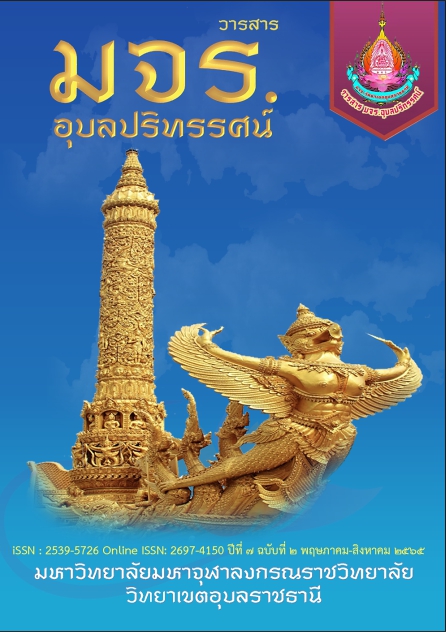THE RELATIONSHIP BETWEEN INNOVATIVE LEADERSHIP OF SCHOOL ADMINISTRATORS AND EDUCATIONAL INNOVATOR OF THE TEACHERS UNDER THE SECONDARY EDUCATION SERVICE AREA OFFICE 13
Main Article Content
Abstract
The purposes of this research are to examine 1) Innovative leadership of school administrators under the secondary education service area office 13. 2) Educational innovator of the teachers under the secondary education service area office 13 and 3) the relationship between innovative leadership of school administrators and educational innovator of the teachers under the secondary education service area office 13. The sampling groups consisted of 327 teachers in schools under the secondary education service area office 13. They were selected based on the kregcie and Morgan’s sample size determination. A constructed 5-level rating scale questionnaire with the reliability of 0.99. The statistics used to analyze data were frequency, percentage, mean, standard deviation, Pearson product moment correlation coefficient and multiple regression analysis were applied by using SPSS (Statistical package for social sciences). The results showed that 1) Innovative leadership of school administrators under the secondary education service area office 13 was at a high level (=3.81, S.D.=1.05) of overview. The highest mean score was vision to change, following by team work and participation and innovative organization of same mean score. And the lowest mean score was creative thinking. 2) Educational innovator of the teachers under the secondary education service area office 13 was at a high level (=3.77, S.D.=0.92) of overview. The highest mean score was working with others, following by connecting to action, open thought and analysis/planning of same mean score. And the lowest mean score was creative originality. 3) The relationship between innovative leadership of school administrators and educational innovator of the teachers under the secondary education service area office 13 was indicated positive correlation at level as highest (r=0.853) with statistically significant at the 0.01 level. The four aspects of innovative leadership of school administrators was team work and participation (), vision to change (), innovative organization () and creative thinking (). There was the effect of the educational innovator of the teachers under the secondary education service area office 13. There were 74.2% with statistically significant at the 0.05 level. These could be formed as the regression equations of unstandardized score and standardized score as follows; The unstandardized score equation: = 1.145+0.033()+0.101()+0.292 ()+0.295() The standardized score equation: = 0.041()+0.123()+0.368()+0.372 ()
Article Details
References
กระทรวงศึกษาธิการ. (2559). คู่มือการประชุมเชิงปฏิบัติการชี้แจงแนวทางการดำเนินงานโครงการโรงเรียนประชารัฐ โครงการสานพลังประชารัฐด้านการศึกษาพื้นฐานและการพัฒนาผู้นำ. กรุงเทพฯ: สำนักพัฒนานวัตกรรมการจัดการศึกษา สำนักงานคณะกรรมการการศึกษาขั้นพื้นฐาน.
เกรียงกานต์ กาญจนะโภคิน. (2563). ผู้นำด้านนวัตกรรมในกรุงเทพธุรกิจ. [Online]. Available: http://www.bangkokbiz news.com/blog/detail/466874, [2563, กุมภาพันธ์ 20].
จรุณี เก้าเอี้ยน. (2556). คุณลักษณะผู้นำเชิงนวัตกรรมของผู้บริหารสถานศึกษาในบริบทสังคมพหุวัฒนธรรม. รายงานวิจัย :มหาวิทยาลัยราชภัฏยะลา.
จีราภา ประพันธ์พัฒน์. (2560). การศึกษาภาวะผู้นําเชิงนวัตกรรมของผู้บริหารสถานศึกษาตามความคิดเห็นของครูสังกัดสำนักงานเขตพื้นที่การศึกษาประถมศึกษาปทุมธานี. บัณฑิตวิทยาลัย : มหาวิทยาลัยเทคโนโลยีราชมงคลธัญบุรี.
ปวีณา กันถิน. (2560). ภาวะผู้นำเชิงนวัตกรรมของผู้บริหารสถานศึกษาโรงเรียนประชารัฐเขตพื้นที่การศึกษาประถมศึกษาเชียงใหม่ เขต 5. บัณฑิตวิทยาลัย :มหาวิทยาลัย
เชียงใหม่.
พยัต วุฒิรงค์. (2555). การจัดการนวัตกรรม: จากแนวคิดสู่การปฏิบัติที่เป็นเลิศ. กรุงเทพฯ: จุฬาลงกรณ์มหาวิทยาลัย.
พรรณี ลีกิจวัฒนะ. (2554). วิธีการวิจัยทางการศึกษา. พิมพ์ครั้งที่ 7. กรุงเทพฯ: มีนเซอร์วิส ซัพพลาย.
วชิน อ่อนอ้าย. (2558). รูปแบบการพัฒนาโรงเรียนเอกชนสู่ความเป็นองค์การแห่งนวัตกรรม. วารสารศึกษาศาสตร์ มหาวิทยาลัยนเรศวร, 17(2), 74-84.
วสันต์ สุทธาวาศ. (2558). การพัฒนาโปรแกรมเสริมสร้างศักยภาพความเป็นนวัตกรการศึกษา. บัณฑิตวิทยาลัย :มหาวิทยาลัยศิลปากร.
วิจารณ์ พานิช. (2555). วิถีสร้างการเรียนรู้เพื่อศิษย์ในศตวรรษที่ 21. กรุงเทพฯ: มูลนิธิสดสรี-สฤษดิ์วงศ์.
เวียงวิวรรธน์ ทำทูล. (2557). ภาวะผู้นำเชิงนวัตกรรมของผู้บริหารที่ส่งต่อองค์การขีดสมรรถนะสูง ของโรงเรียนในสังกัดสำนักงานเขตพื้นที่การศึกษามัธยมศึกษา เขต 21. บัณฑิตวิทยาลัย : มหาวิทยาลัยขอนแก่น.
สำนักงานคณะกรรมการพัฒนาการเศรษฐกิจและสังคมแห่งชาติ. (2559). แผนพัฒนาเศรษฐกิจและสังคมแห่งชาติ ฉบับที่สิบสอง พ.ศ.2560-2564. สำนักนายกรัฐมนตรี.
______. (2561). ยุทธศาสตร์ชาติ พ.ศ.2561-2580. สำนักเลขานุการของคณะกรรมการยุทธศาสตร์ชาติ.
อนุพงษ์ ชุมแวงวาปี. (2560). การพัฒนารูปแบบองค์การแห่งนวัตกรรมของโรงเรียนมัธยมศึกษา สังกัดสำนักงานคณะกรรมการการศึกษาขั้นพื้นฐาน. บัณฑิตวิทยาลัย : มหาวิทยาลัยบูรพา.
อรพิน อิ่มรัตน์. (2561). ปัจจัยที่ส่งผลต่อภาวะผู้นำเชิงนวัตกรรมของผู้บริหารสถานศึกษาในสังกัดสำนักงานเขตพื้นที่การศึกษาประถมศึกษาชลบุรี เขต 3. บัณฑิตวิทยาลัย :มหาวิทยาลัยสุโขทัยธรรมาธิราช.
Krejcie, R. V. & Morgan, D.W. (1970). Determining sample size for research activities. Educational and Psychological Measuremen, 30, 607-610.
Likert, R. (1967). The Method of Constructing and Attitude Scale: Reading in Attitude Theory and Measurement. New York: Wiley & Son.
Rogers, Everett M. & F. Floyd Shoemaker. (1995). Communication of Innovations: A Cross Cultural Approach. New York: The Free Press.
Tepic, Mersiha & et al. (2013). Complexities in Innovation Management in Companies from the European Industry: A Path Model of Innovation Project Performance Determinants. European Journal of Innovation Management, 16, 517–550.
Volk, K., Yip, W. M., & Lo, T. K. (2012). Hong Kong pupils' attitudes toward technology: The impact of design and technology programs. [Online]. Available: http://scholar.lib.vt.edu/ejournals/JTE/v15n1/volk.html. [2563, February 20].
Williamson, Doug. (2011). Mining for Hidden Human Potential. Human Resource Management International Digest, 19(7), 3–8.
Yuduo, Lu & et al. (2011). Implications of I Ching on Innovation Management. Chinese Management Studies, 5, 394–402.

